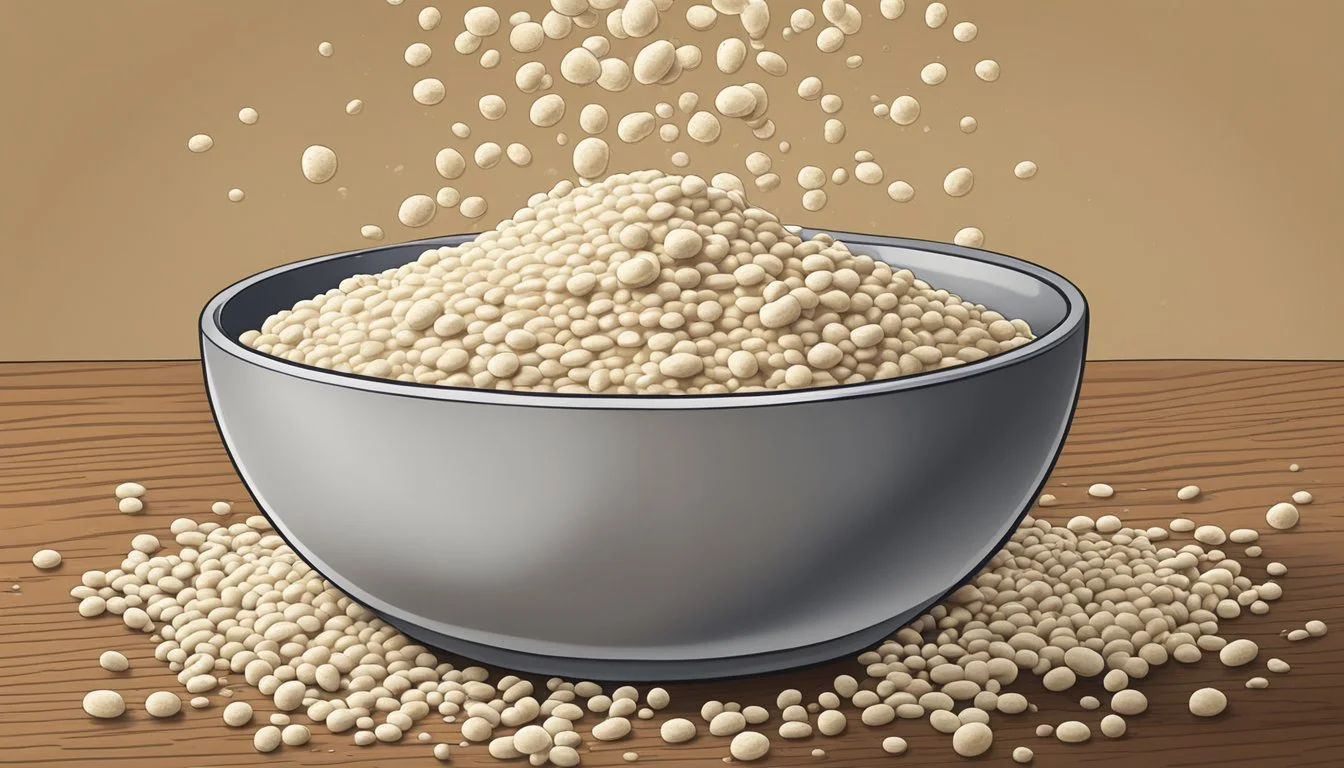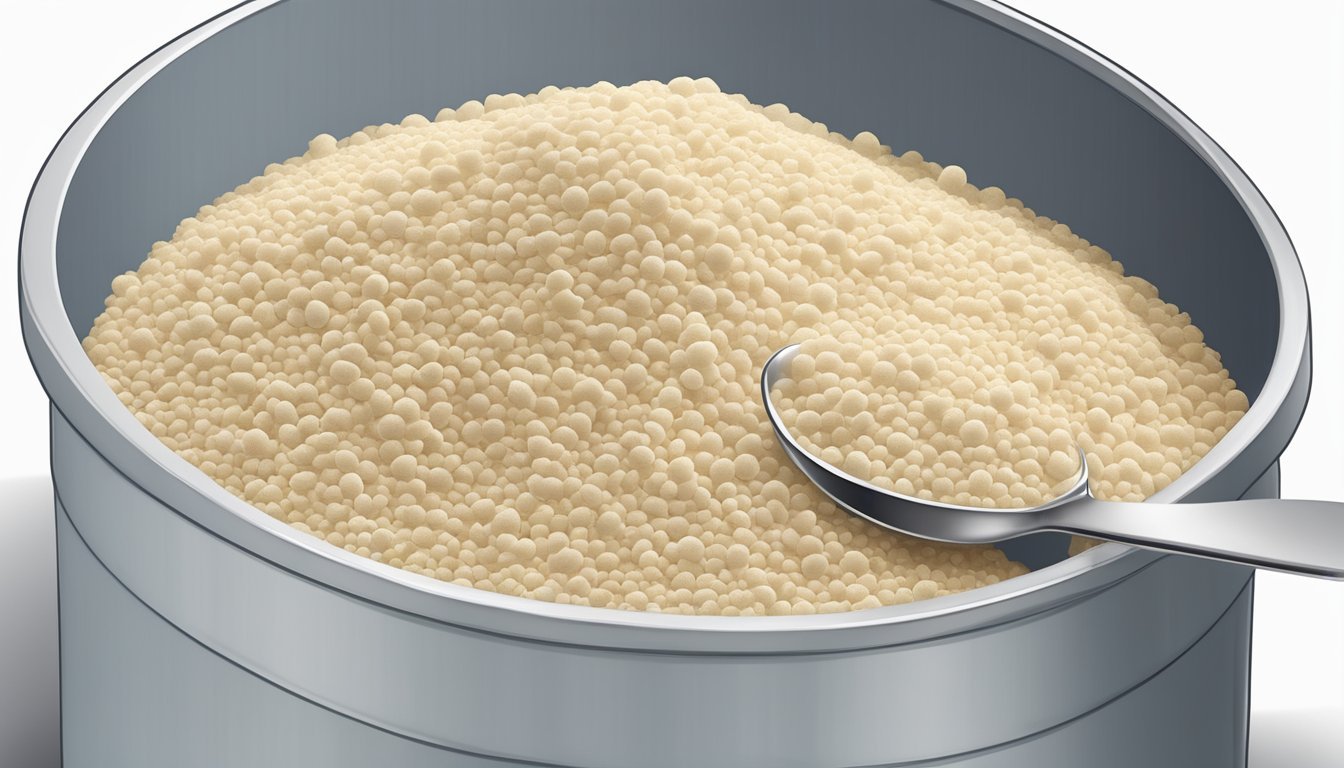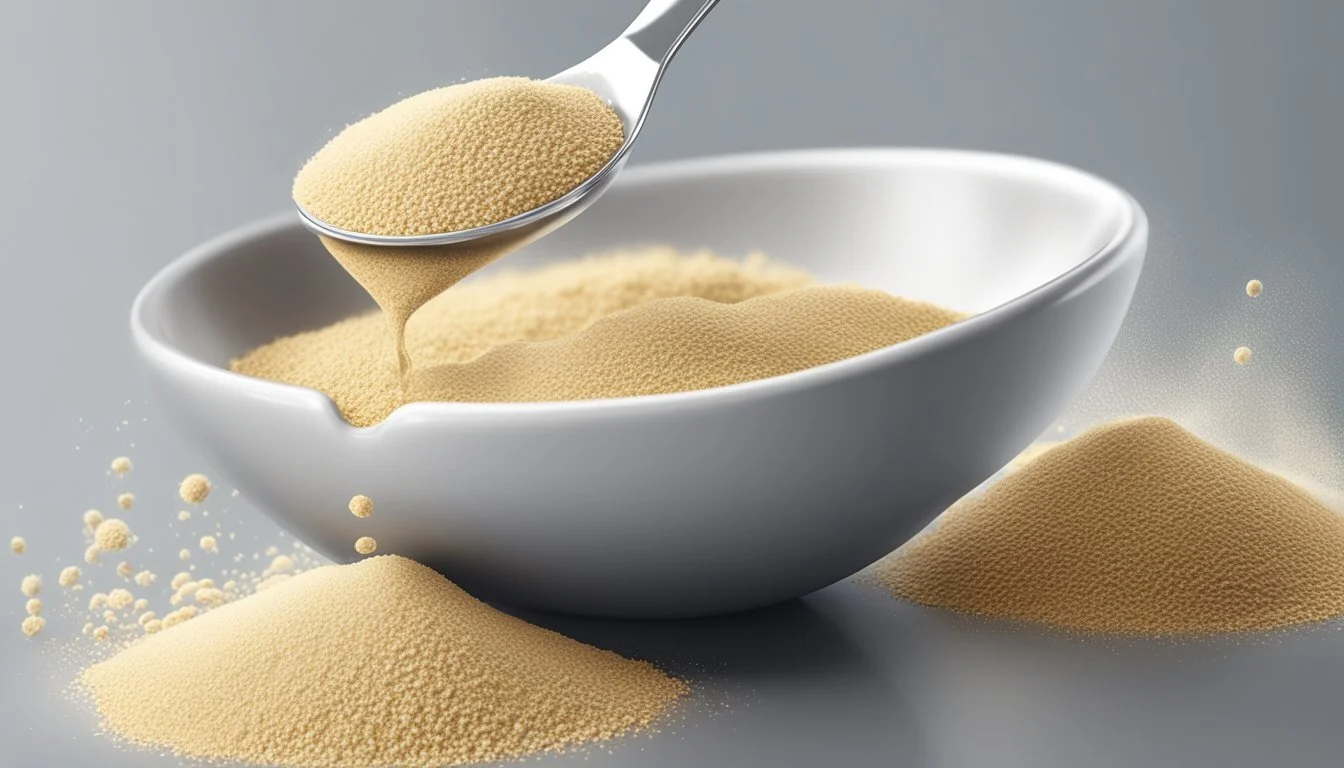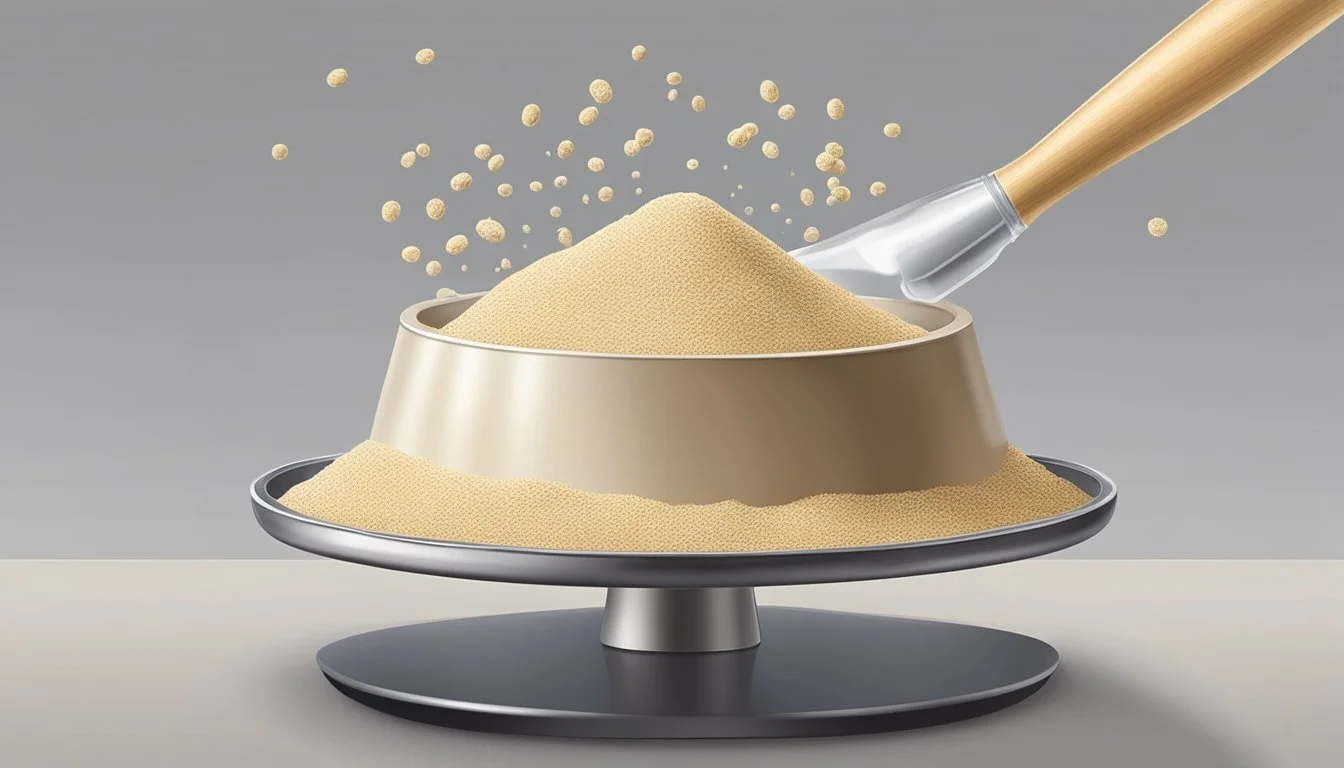How Many Tablespoons in a Pound of Active Dry Yeast
Accurate Measurement Guide
Measuring ingredients accurately is crucial in baking, as the precise amount can make the difference between a perfectly risen bread and a disappointing bake. When it comes to baking with active dry yeast, understanding the conversion between weight and volume units is essential for recipe success. One pound of active dry yeast equates to approximately 53.33 tablespoons, a conversion that helps in scaling recipes up or down or complying with package sizes available.
Active dry yeast is a common leavener used by both professional and home bakers to help dough rise. Packaging and recipes often refer to yeast in different measurements, which may require conversion. It is important for bakers to have a clear idea of these conversions to ensure their recipes have the correct proportion of yeast. Whether the recipe calls for a pound, a tablespoon, or even teaspoons, knowing how to convert these units allows for flexibility and precision in baking.
Understanding Yeast and Its Types
In the world of baking, yeast is the driving force behind fermentation, the process that gives bread its rise and texture. This section explores the different varieties of yeast commonly used in baking and breaks down their characteristics.
Active Dry Yeast vs Fresh Yeast
Active Dry Yeast is a granulated form of Saccharomyces cerevisiae, which has been dehydrated. Before use, it's generally dissolved in warm water to 'activate' it. Active dry yeast is robust, with a longer shelf life than fresh yeast, making it a preferred choice for home bakers.
Fresh Yeast, also known as cake yeast or compressed yeast, is a block of fresh Saccharomyces cerevisiae cells with a high moisture content. It's highly perishable and often favored by professional bakers for its quick fermentation properties. However, it requires refrigeration and typically expires within a couple of weeks.
Yeast Type Shelf Life Preparation Required Active Dry Yeast Longer shelf life; requires storage in a cool, dry place Must be dissolved in warm liquid Fresh Yeast Short shelf life; requires refrigeration Can be crumbled directly into the dough or dissolved in water
Instant Yeast and Bread Machine Yeast
Instant Yeast, also termed as rapid-rise or quick-rise yeast, is a finely milled form of active dry yeast that can be mixed directly with dry ingredients. It is a versatile yeast that requires one rise and is suitable for bread machines.
Bread Machine Yeast is essentially instant yeast that is specifically formulated for the quick cycles of a bread machine. Its granules are more absorbent, which enables it to react quicker than active dry yeast but with similar results.
Other Yeast Varieties
Apart from the aforementioned types, other varieties of yeast like Brewer's Yeast are also used. Brewer's yeast, a byproduct of beer making, is also a type of Saccharomyces cerevisiae but is used typically for nutritional supplements rather than baking, due to its bitter taste.
Yeast Types in baking are predominantly variations of Saccharomyces cerevisiae, a type of fungi that is invaluable in food production. While active dry, fresh, and instant yeasts are most commonly applied in bread making, exploring lesser-known types can yield a wide array of flavors and textures in baking pursuits.
Measuring Yeast
Accurate measurement is crucial for the success in baking, especially when it comes to yeast, a key ingredient for breads and pastries. A pound of active dry yeast contains approximately 53.33 tablespoons, crucial knowledge for scaling recipes or performing conversions between volume and weight.
Converting Yeast Measurements
It's important for bakers to convert yeast measurements to match their specific recipe requirements. For active dry yeast, the following unit measures are often used in recipes:
Weight to Volume: 1 pound of active dry yeast is equivalent to 53.33 tablespoons (tbsp).
Volume to Weight: 1 tablespoon of active dry yeast is approximately 0.268 ounces or 7.6 grams.
Here is a simple table to assist with common conversions:
Quantity Active Dry Yeast 1 lb 53.33 tbsp 1 tbsp 0.268 oz 1 packet 2.25 tsp 1 cup ~40.58 tbsp
When converting between different types of yeast, such as active dry to instant yeast, one should apply a ratio of 1:1.5. For example, if a recipe calls for 4 tbsp of instant yeast, they will need 6 tbsp of active dry yeast.
Yeast Measurement Tools
Accurate measuring tools are indispensable for working with yeast. One can rely on:
Measuring Spoons and Cups: They use these for both liquid and dry ingredients and are essential for measuring small amounts of yeast, commonly in tablespoons (tbsp), teaspoons (tsp), and cups.
Kitchen Scales: They prefer scales for larger or more precise measurements, especially for yeast, where weight is a more reliable measure than volume. Measurements are typically in ounces (oz) or grams (g).
Bakers should be aware that a packet of yeast in the United States typically contains a quarter ounce, or 2.25 teaspoons, which is approximately 7 grams. This standard packet size can be used as a quick reference for yeast recipes.
Baking with Yeast
Baking with yeast is a fundamental aspect of creating leavened bread and pizza (What wine goes well with pizza?) dough. Understanding the role of yeast and the precise measurements needed ensures the success of these culinary endeavors.
Yeast in Bread Baking
Yeast is the driving force behind the fermentation process in bread baking. For every pound of active dry yeast, one can measure out 53.33 tablespoons. This conversion is essential for bakers as recipes often call for varying quantities of yeast based on the bread type and desired texture.
The fermentation process not only helps the dough rise, but it also contributes to the development of flavor. The ideal temperature for yeast to thrive ranges from 70°F to 100°F. However, maintaining temperatures on the lower end of this spectrum during dough rising is advantageous. It allows flavors to develop more fully before the bread is shaped and baked. The ingredients, commonly flour, sugar, and salt, must be balanced to ensure the yeast activates properly without being hindered by excessive sugar or salt, which can impair yeast function.
Baking Pizza Dough
When crafting pizza dough, yeast performs similarly to bread baking but targets a thinner, crisper crust. Achieving the perfect pizza crust hinges on the correct yeast measurement, dough handling, and baking temperature. Active dry yeast is favored for its consistency and shelf life, making it ideal for many pizza dough recipes.
The temperature again plays a critical role; pizza dough requires a warm environment to rise effectively. The oven can be preheated to a low temperature, around 150°F, and then turned off. Placing the dough in the oven for about 30 minutes creates a conducive environment for yeast activity, leading to a well-risen pizza crust. After the initial rise, bakers often adjust the oven temperature and baking duration to achieve the desired crispness and color of the pizza crust.
Yeast Conversion and Substitution
The precise conversion of yeast types is crucial for the success of any baking endeavor. This section navigates through the specifics of measuring active dry yeast and the interchangeability with other yeast types.
Active Dry Yeast Conversion
For active dry yeast, the conversion factor to tablespoons is that one pound is equivalent to approximately 53.33 tablespoons. This conversion is essential when scaling recipes up or down or when using bulk yeast to comply with the specifications of a recipe.
Yeast Conversion Chart
A yeast conversion chart is an invaluable tool for bakers, facilitating the translation between different forms and quantities of yeast. The chart typically lists equivalencies, such as fresh yeast to dry yeast or instant yeast to active dry yeast, ensuring accuracy in substituting one for another.
Interchanging Different Types of Yeast
Substituting instant yeast for active dry yeast requires a reduction in volume due to the higher concentration of live cells in instant yeast. When interchanging these yeasts, one should reduce the instant yeast by 25 percent. Conversely, to substitute instant yeast with active dry yeast, multiply the required quantity of instant yeast by 1.5. This ensures the leavening power in the dough remains consistent.
The Science of Yeast
Yeast plays a vital role in baking, specifically through the fermentation process, which produces gases that leaven baked goods. Understanding these scientific principles is crucial for successful baking outcomes.
Fermentation Process
Yeast cells metabolize sugars, primarily glucose and fructose, in a process known as fermentation. During fermentation, yeast converts these sugars into carbon dioxide and alcohol. The production of carbon dioxide is pivotal in the context of baking as it contributes to the leavening action. In active dry yeast, this fermentation is slower compared to instant varieties, thereby affecting the rise time of the dough.
Key points of fermentation:
Yeast ferments sugars into carbon dioxide and alcohol
Rise time is influenced by the rate of fermentation
Leavening in Baking
In baking, yeast is considered a natural leavening agent due to its ability to produce carbon dioxide gas through fermentation. When yeast is mixed into dough comprising flour and water, gluten networks form. It's these elastic gluten strands that trap the carbon dioxide produced by the yeast, causing the dough to expand and rise. The timing and temperature conditions are critical for optimal yeast performance and are intrinsically linked to the quantity of yeast used.
Aspects of yeast in leavening:
Carbon dioxide from yeast causes dough to rise
Gluten networks in dough trap gases effectively
These components operate in tandem to create the airy and soft textures characteristic of well-leavened baked goods.
Optimal Conditions for Yeast Activation
In baking, the activation of yeast is a crucial step that determines the success of fermentation. Proper temperature control and rising techniques can significantly influence yeast performance.
Temperature and Yeast Activity
Activating active dry yeast requires a specific range of temperatures to ensure it comes alive and contributes to dough rising. Water temperature should be between 105℉ (40℃) and 115℉ (46℃) for active dry yeast, while instant yeast requires a temperature range from 120-130℉ (49-55℃). Exceeding 138℉ (59℃) may result in the death of the yeast, halting the fermentation and rising process. For ideal conditions, water should be pre-measured with a thermometer to maintain accuracy.
Active dry yeast: 105℉ (40℃) to 115℉ (46℃)
Instant yeast: 120℉ (49℃) to 130℉ (55℃)
Maximum threshold: 138℉ (59℃)
Proofing and Rising Techniques
The proofing stage is essential for checking the viability of yeast and encouraging a slow, steady rise. A common method involves dissolving yeast in warm water, sometimes with the addition of sugar, to provide "food" for the yeast, ultimately aiding in fermentation. After mixing, one waits for about 10 minutes to observe if the mixture becomes bubbly, indicating active yeast. For the rising of the dough, cooler conditions are generally preferred. Temperatures between 70°F and 100°F are suitable, with slower rising at the lower end promoting more flavor development during fermentation.
Proofing: Dissolve yeast in a warm liquid, wait for bubbles.
Slow rising: Cooler temperatures (70°F to 100°F) favored for flavor.
Storing and Preserving Yeast
Proper storage is essential for maintaining the freshness and potency of active dry yeast. This section outlines best practices for long-term storage and key considerations for preserving yeast freshness and expiry.
Long-Term Storage
For long-term storage, active dry yeast should be kept in a cool and dry place to maximize its shelf life. An airtight container is optimal, and transferring yeast to a glass jar can provide an additional layer of protection. If the yeast is purchased in bulk, dividing it into smaller portions can prevent contamination of the unused portion.
Refrigeration: Yeast can be stored in the refrigerator, where the colder temperatures slow down yeast activity.
Freezer: For extended storage, the freezer is the best option. Yeast can be frozen for several months, and possibly longer, without significant loss of potency.
When storing yeast in the freezer or refrigerator, ensure that it's sealed properly to avoid moisture, which can degrade the yeast quality.
Yeast Freshness and Expiry
The freshness of active dry yeast directly affects the rise and texture of baked goods. To check the viability of yeast:
Dissolve 1 teaspoon of sugar in 1/2 cup of warm water (100°F to 110°F).
Sprinkle 2 teaspoons of yeast over the sugar solution.
Wait for 10 minutes. Fresh yeast will become frothy and start to expand, indicating that it's active.
It's imperative to note the expiry date provided by the manufacturer. While yeast can remain viable beyond this date, its ability to leaven will gradually diminish. Regular viability checks are recommended, especially if the yeast is being used past its expiry date.
Advanced Baking Techniques
In advanced baking, precision is paramount, especially when converting weight to volume for ingredients such as active dry yeast. Understanding the density and behavior of yeast can differentiate between a good bake and a great one.
Professional Baking Insights
Professional bakers often work with large quantities of ingredients and consistency is key to their success. They know that one pound of active dry yeast is equivalent to approximately 53.33 tablespoons. This precise measurement ensures that the yeast's leavening power is consistently harnessed across multiple batches of dough.
In large-scale baking, professionals might use a sponge technique, which involves pre-fermenting part of the dough ingredients. This results in more complex flavors and can also affect how much yeast is used initially.
Sponge Method Basics:
Mix part of the flour, water, and yeast to form a thick batter.
Allow it to ferment until bubbly (usually several hours).
Combine with the remaining ingredients to form the dough.
Pro Tip: Always ensure the temperature of liquids used to activate yeast falls between 70°F and 100°F for optimal yeast activity.
Home Baking Tips
The home cook often measures ingredients for single batches, thus a direct conversion from pounds to tablespoons can be useful for smaller quantities. A digital kitchen scale can be invaluable for home bakers when dealing with measurements that require precision.
Measurement Guide for Home Bakers:
Ingredient Conversion Active Dry Yeast 1 lb = ~53.33 tbsp
A home baker usually finds themselves using packets of yeast, which can vary between 2 and 2.5 tablespoons per packet. It's important that they adjust the number of packets accordingly if a recipe calls for a specific weight of yeast.
Packet Yeast Application:
Check packet size to understand how many tablespoons it contains.
If using the sponge method, account for the packet size in the initial mix.
Remember, home bakers should ensure their yeast is active by proofing it properly: dissolve the yeast in warm water with a bit of sugar, and look for bubbling to indicate readiness.
Using Yeast in Non-Bread Recipes
Yeast, typically associated with bread, also plays a versatile role in non-bread recipes, from alternative baked goods to culinary creations beyond the realm of baking.
Alternative Baking
In alternative baking, yeast can be used to prepare a variety of non-bread items where fermentation is essential to the product's structure and flavor. For instance, in baking sourdough breads, active dry yeast often isn’t necessary as the natural yeast in sourdough starters is sufficient. However, when substituting yeast in recipes traditionally not relying on sourdough starters, careful measurement is critical.
Sweet Goods: In sweets like cinnamon rolls, the yeast interacts with sugar, creating fermentation that allows the pastry to rise.
Example: 2 ¼ teaspoons of active dry yeast are commonly needed for sweet dough.
Savory Dishes: Yeast can also be employed in making savory pastries, like cheese-filled rolls, where it contributes to the light, airy texture.
Yeast Beyond Baking
Active dry yeast has applications beyond traditional baking, serving as a food additive in various culinary processes.
Alcoholic Beverages: The fermentation process in beer making relies on yeast consuming sugars to produce alcohol.
Non-Alcoholic Beverages: Certain drinks, like some ginger ales, use a small quantity of yeast for carbonation.
Meat Substitutes: As a rising health trend, yeast is included in vegetarian and vegan meat substitutes to enhance flavor and nutrient profile.
Yeast in Different Cultures
In this section, we explore the various applications and historical significance of yeast, with a focus on its role in global baking methods and its historical use across different cultures.
Global Baking Methods
Different cultures have developed unique baking methods, often influenced by the type of yeast available. For instance, bread machine yeast is a modern invention tailored to the convenience of automated bread-making appliances. It's a type of instant yeast specifically formulated for bread machines due to its fine texture and rapid-rise properties.
On the other hand, traditional baking often employs a variety of yeast types, each imparting distinct flavors and textures to the final product. These include:
Fresh yeast, typically used in professional bakeries for its strong fermenting power.
Active dry yeast, which requires activation before use and is favored for its longer shelf life.
Instant yeast, known for its convenience as it does not require proofing prior to mixing with flour.
Historical Use of Yeast
Yeast has a storied history, with evidence of its use in baking and brewing dating back thousands of years. In various cultures, yeast emerged independently, illustrating its significance in food and beverage preparation through the ages. The use of yeast in ancient Egypt for brewing beer and leavening bread is well-documented, with hieroglyphics often depicting the baking process.
Moreover, discussions in vintage forums and historical texts reveal the evolution of yeast usage. From natural leavening methods such as sourdough starters to the more recent industrial production of consistent and reliable commercial yeast strains, the journey of yeast in human culture reflects the innovation and adaptability of culinary practices.
DIY and Craft Baking
In the realm of DIY and craft baking, the precision in ingredients and equipment is essential. One pound of active dry yeast equates to approximately 53 tablespoons, a crucial measurement for bakers creating large batches or stocking up their pantry. Constructing a dedicated oven or meticulously crafting dough speaks to the dedication and artistry of the home baker.
Building Your Own Oven
Those venturing into DIY oven construction typically opt for a pizza oven with a round igloo shape. The use of fire-bricks and refractory concrete is a standard approach, providing the oven with the durability to withstand high temperatures. It is also vital to incorporate proper thermal insulation to maintain consistent heat, which is key to achieving that coveted artisanal bake. A well-built oven radiates with steady warmth, making it ideal for perfectly risen doughs infused with the scent of craftsmanship.
Crafting Artisan Dough
For the baker crafting artisan dough, the consistency of the yeast blend is pivotal. Whether creating sourdough or a classic pizza base, the dough must be handled with care. A blend that starts with the precise measurement of active dry yeast ensures a robust rise and a flavorful end product. Artisans may choose to vary the quantity of yeast for desired texture and flavor development, which is especially relevant when baking in ovens crafted with the dedication of a true craftsman.
Additional Resources
When measuring active dry yeast, precision is essential for successful baking. This section provides comprehensive resources for bakers seeking to source the best yeast and gain deeper knowledge through educational materials.
Yeast Manufacturers and Suppliers
Yeast Manufacturers are the cornerstone of baking supplies. They provide a variety of products tailored for different baking needs. Notable manufacturers include:
Red Star Yeast: Offering a range of yeast products suitable for both home bakers and professionals.
SAF Yeast: Well-known for their quality instant and active dry yeast.
Fleischmann’s Yeast: A popular choice among bakers for their reliable active dry and instant yeast options.
Purchasers can consult each manufacturer's site map for a comprehensive list of products and baking resources.
Educational Material and Consulting
For bakers seeking to expand their knowledge:
King Arthur Baking Company: Provides an array of educational resources ranging from baking guides to recipes.
The Bread Bakers Guild of America: Offers workshops and consulting services for individuals looking to refine their baking skills.
Those who require consulting help can connect with industry experts through professional culinary institutes or baking associations that offer tailored advice and training. These services are invaluable for both novices and experienced bakers who wish to ensure the right yeast measurements and techniques are applied.












